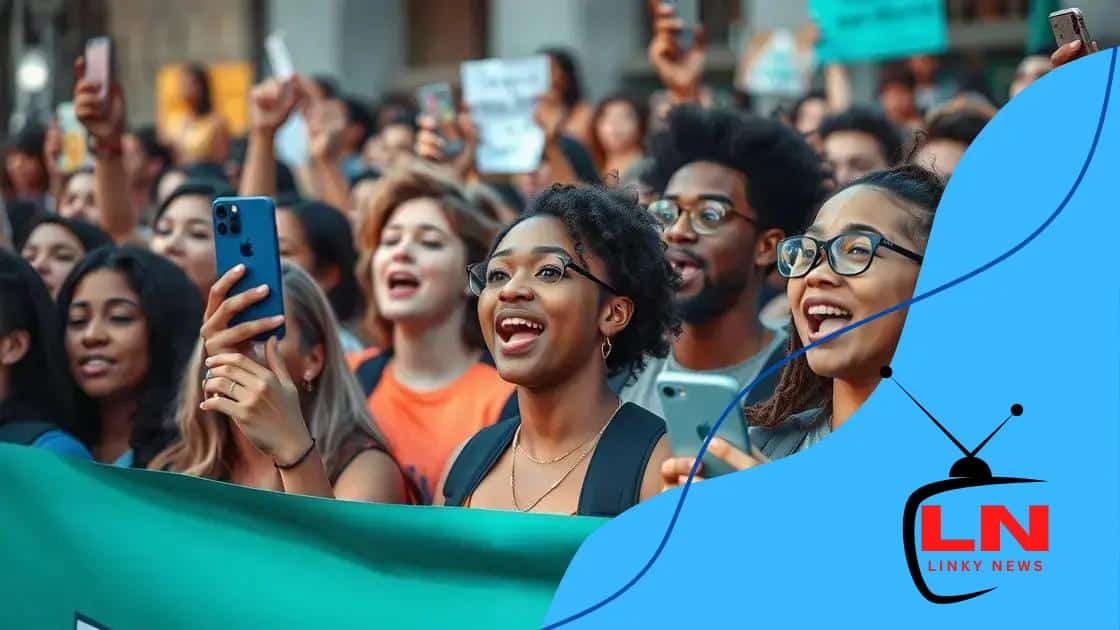Social media’s impact on youth activism

Social media’s impact on youth activism is profound, enabling young activists to organize, engage, and amplify their messages globally, while also presenting challenges like harassment and misinformation.
Social media’s impact on youth activism is a game changer, allowing young people to connect and mobilize like never before. Have you noticed how a tweet or post can spark movements?
The role of social media in modern activism
Social media plays a crucial role in modern activism, especially among young people. It acts as a powerful tool for communication, enabling quick sharing of ideas and mobilization for causes.
One major aspect of social media in activism is its ability to reach a wide audience. Platforms like Twitter, Instagram, and Facebook allow activists to share their messages with thousands, or even millions, of people instantly. This rapid dissemination of information is essential for raising awareness about issues that matter.
How Social Media Facilitates Activism
Activists use social media to organize events and campaigns effectively. With just a few clicks, they can create online petitions, organize protests, or rally support for legislative changes. This ease of use empowers more individuals to get involved in activism.
- Immediate communication and updates on events
- Engagement through hashtags and trending topics
- Opportunities for collaboration across regions
- Accessibility for those who may not attend in-person events
Additionally, social media allows for storytelling and sharing personal experiences. By amplifying individual voices, these platforms help humanize causes, making issues like climate change or social justice more relatable.
Challenges of Social Media Activism
Despite its positive impact, there are challenges associated with social media activism. Increased visibility can lead to serious backlash. Activists often face criticism and threats online, which can deter participation. Another significant challenge is the issue of online misinformation; it can spread quickly and undermine genuine activism.
Furthermore, the phenomenon known as “slacktivism” can occur, where individuals feel they have contributed to a cause simply by liking a post or sharing a link without taking further action. This can dilute the effectiveness of real activism.
In conclusion, social media has transformed the landscape of activism, offering both opportunities and challenges. Its ability to connect, inform, and empower is unmatched, making it a valuable tool in the fight for social change.
How platforms empower youth voices
Social media platforms significantly empower youth voices, providing them with tools to express their opinions and advocate for change. These platforms create spaces where young people can share their stories and connect with like-minded individuals.
With accessibility at the forefront, platforms like TikTok, Instagram, and Twitter encourage creativity and personal expression. Young activists can create videos, graphics, and posts that resonate with their peers. This engagement not only amplifies their message but also fosters community support.
The Impact of a Supportive Community
When youth come together on social media, they can build a strong support network. This communal aspect helps encourage more young people to join movements and participate actively in social issues.
- Sharing experiences leads to solidarity.
- Youth-led campaigns gain traction through collaboration.
- Peer support helps combat feelings of isolation.
- Increased visibility of diverse perspectives strengthens messages.
Moreover, platforms allow youth to lead discussions about vital issues like climate change, racial equality, and mental health. By focusing on these topics, they bring attention to matters that deeply affect them and their communities. Videos discussing these issues can go viral, creating a ripple effect that inspires others to speak up.
The Role of Hashtags and Trends
Utilizing hashtags is another powerful way youth mobilize support. By creating or joining trending hashtags, young activists can increase the visibility of their messages. Hashtags like #BlackLivesMatter or #ClimateStrike have shown how online movements can lead to real-world actions and discussions.
As young people continue to find their voices online, they also use social media to challenge narratives and misinformation. This active engagement helps cultivate critical thinking and empathy among users, making them informed advocates for change.
In the modern landscape, the ability to harness social media effectively can drive change in ways that traditional methods sometimes cannot. With platforms serving as their megaphones, today’s youth are confident and determined to create a better future.
Challenges faced by youth activists on social media

Youth activists face numerous challenges on social media while striving to make a difference. Although platforms offer powerful tools for organization and outreach, there are hurdles that can complicate their efforts.
One significant challenge is online harassment. Many young activists encounter negative comments, threats, and bullying from users who oppose their views. This hostile environment can discourage participation and silence important voices.
Amplifying the Message
To combat this, youth must find ways to protect their mental health and continue advocating for their causes. Many activists take breaks from social media to recharge and regroup after facing negativity. They also rely on the support of friends and peers to stay motivated.
- Blocking or reporting harmful users
- Creating safe spaces for discussion
- Engaging with supportive communities
- Practicing self-care and mindfulness techniques
Another challenge that youth activists encounter is the issue of misinformation. False information can spread rapidly on social media, confusing audiences and undermining credibility. Activists must be diligent in verifying information before sharing it. They often take it upon themselves to educate their followers about reliable sources and critical thinking.
The Pressure of Visibility
Additionally, the pressure of constant visibility can be overwhelming. Youth activists are expected to respond and engage with their audience continually. This high expectation can lead to burnout and mental exhaustion, especially when facing criticism and scrutiny.
Furthermore, there is a risk of “slacktivism.” Some people participate in online movements through likes or shares without taking any real-world action. This can make it harder for youth activists to gauge genuine support and engagement.
Case studies of successful youth activism campaigns
Studying successful youth activism campaigns provides valuable insights into how social media can be used effectively. One notable example is the March for Our Lives movement, initiated by survivors of the Stoneman Douglas High School shooting. This campaign mobilized youth across the country to advocate for stricter gun control laws.
By using social media platforms like Twitter and Instagram, the organizers created a viral call to action. They encouraged young people to share their stories, participate in protests, and engage with lawmakers. This approach not only raised awareness but also highlighted the power of youth voices in shaping public policy.
Climate Strikes and Global Impact
Another compelling case is the Fridays for Future movement, started by Greta Thunberg. Thunberg, a young climate activist, began striking from school to demand action on climate change. Her actions sparked a global phenomenon, inspiring millions of students to join her in climate strikes every Friday.
- Utilization of hashtags like #FridaysForFuture increased visibility.
- Collaboration with international youth groups helped amplify the message.
- Social media campaigns provided instant updates and mobilization efforts.
- Personal stories and images brought emotional engagement to the issue.
The impact of these campaigns highlights the effectiveness of using social media strategically. Through platforms, youth activists can reach beyond local communities, capturing global attention and fostering a sense of urgency around critical issues.
Social Justice Movements
Additionally, the Black Lives Matter movement showcases how youth activists have utilized social media to promote social justice and equality. Launched in response to police violence against black individuals, this movement has organized protests and educational campaigns worldwide.
Youth have played vital roles in spreading the message through powerful visuals and impactful storytelling. With hashtags like #BlackLivesMatter, they have united voices and created a movement that resonates across generations. These campaigns illustrate that when young people leverage social media well, they can create substantial change and inspire others to take action.
The future of activism with social media
The future of activism with social media looks promising, as technology continues to evolve and connect people globally. Social media platforms are increasingly becoming vital tools for organizing and driving social change.
As technology advances, new features will provide even more opportunities for engagement. For instance, live streaming and interactive content allow activists to reach larger audiences in real-time. This kind of engagement helps build a sense of community and urgency around important issues.
Empowering Youth through Technology
Young activists are leading the way in utilizing these advancements. By embracing new technologies, they can organize campaigns faster and more efficiently than ever before. This adaptability enables them to respond to issues as they arise, keeping the conversation alive.
- Enhanced collaboration through shared platforms.
- Ability to mobilize support for urgent causes almost instantly.
- Use of multimedia content to express ideas creatively.
- Global participation in local movements through social media.
The potential for social media to engage more diverse voices is another exciting aspect of its future. With increasing access to the internet and rising smartphone usage, more people can share their stories. This inclusiveness creates a richer dialogue about pressing social issues.
The Role of Algorithms and Data
However, challenges remain. Algorithms can influence the visibility of content, sometimes sidelining crucial messages in favor of more popular ones. Activists must understand how these algorithms work to effectively promote their causes. By strategizing their online presence, they can ensure their messages reach a wider audience.
Moreover, data privacy concerns also play a role in activism’s future. As young people become more aware of these issues, they may push for transparency and protections in how their data is used. This could foster a more secure platform for activism.
Overall, the future of activism with social media will continue to evolve, reflecting the needs and creativity of younger generations. As long as youth harness the power of technology, activism will thrive and adapt to an ever-changing landscape.
FAQ – Questions about social media’s impact on youth activism
How does social media empower youth activists?
Social media empowers youth activists by providing a platform to share their voices, organize events, and reach a wider audience instantly.
What are some successful youth activism campaigns?
Successful youth activism campaigns include March for Our Lives and Fridays for Future, which utilized social media for awareness and mobilization.
What challenges do youth activists face on social media?
Youth activists often face challenges like online harassment, misinformation, and the pressure of constant visibility, which can hinder their efforts.
What does the future of activism with social media look like?
The future of activism with social media is bright, as technology advances will enable more creative engagements and broaden the reach of youth-led movements.





